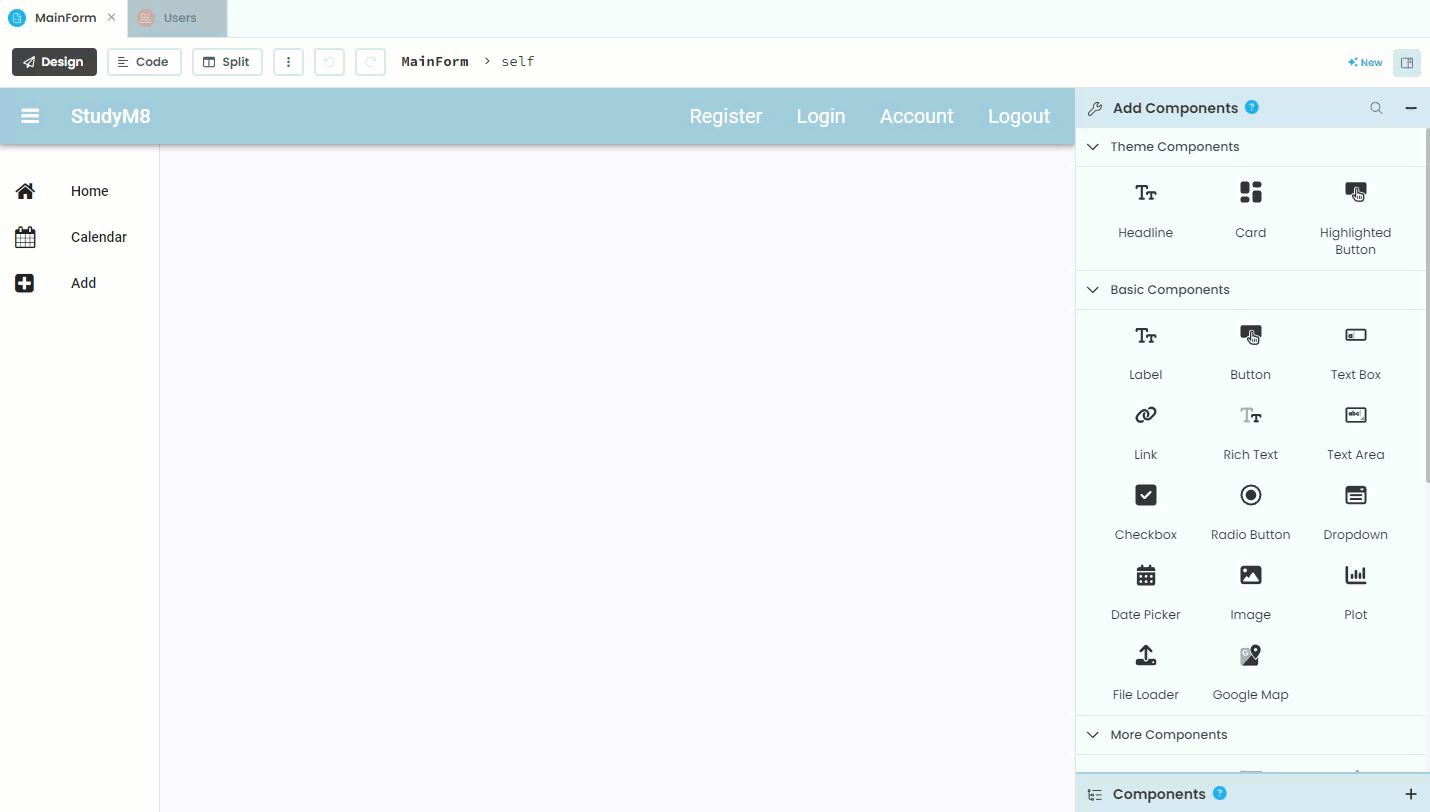User Management Features¶
In this tutorial you will incorporate user management features to allow users to:
Register for an account
Login with a registered account
Logout of the website
The events that trigger all these features will be link clicks, so we have to go back to the MainForm Design mode and create handlers for the Register, Login and Logout links.

Code¶
Register¶
The first feature we need to add is the registration feature so we can create users.
Go to the link_register_click handler. Delete the comment and the pass statement. Then add the highlighted code below:
63 def link_register_click(self, **event_args):
64 anvil.users.signup_with_form(allow_cancel=True)
Code explaination
line 64:
signup_with_form→ use the built-in registration formanvil.users.→ from the Anvil user managment toolallow_cancel=True→ add a cancel button to the registration form
Launch your website and try to register an account.

Stop your website and check that your account has been created in the users table.

Logout¶
Since we are remembering the user, we now need to be able to logout.
Go to the link_logout_click handler. Delete the comment and the pass statement. Then add the highlighted code below:
70 def link_logout_click(self, **event_args):
71 anvil.users.logout()
Code explaination
line 70:
logout()→ use the built-in logout featureanvil.users.→ from the Anvil user management tool
Login¶
Finally we need to allow users already registered to login
Go to the link_login_click handler. Delete the comment and the pass statement. Then add the highlighted code below:
66 def link_login_click(self, **event_args):
67 anvil.users.login_with_form(allow_cancel=True)
Code explaination
line 67:
login_with_form→ use the built-in login formanvil.users.→ from the Anvil user managment toolallow_cancel=True→ add a cancel button to the registration form
Test¶
Run the test¶
It is really hard to test if our user features work, as we have no indication if the user is logged in or not. To solve this we will add some testing code to the handlers.
63 def link_register_click(self, **event_args):
64 anvil.users.signup_with_form(allow_cancel=True)
65 print("Register", anvil.users.get_user())
66
67 def link_login_click(self, **event_args):
68 anvil.users.login_with_form(allow_cancel=True)
69 print("Login", anvil.users.get_user())
70
71 def link_logout_click(self, **event_args):
72 anvil.users.logout()
73 print("Logout", anvil.users.get_user())
Code explaination
All three are estentially the same, so I’ll just explain the first.
line 65:
print→ send to the terminal"Register"→ the name of the link just clickedanvil.users.get_user()→ what the current user is
Launch your website, then:
Register another user
Logout
Login using your new user
Notice your terminal has three new messages:

Click on the Terminal tab and you should have the three messages below.

Tidy up¶
If you received the same messages, your test passed.
Go back into the MainForm code and remove the three print statements.
Final code state¶
By the end of this tutorial your code should be the same as below:
Final MainForm¶
1from ._anvil_designer import MainFormTemplate
2from anvil import *
3import anvil.tables as tables
4import anvil.tables.query as q
5from anvil.tables import app_tables
6import anvil.users
7from ..HomeComponent import HomeComponent
8from ..CalendarComponent import CalendarComponent
9from ..AddComponent import AddComponent
10from ..AccountComponent import AccountComponent
11
12
13class MainForm(MainFormTemplate):
14 def __init__(self, **properties):
15 # Set Form properties and Data Bindings.
16 self.init_components(**properties)
17 self.breadcrumb_stem = self.label_title.text
18
19 # Any code you write here will run before the form opens.
20 self.content_panel.add_component(HomeComponent())
21 self.set_active_link("home")
22
23 def set_active_link(self, state):
24 if state == "home":
25 self.link_home.role = "selected"
26 else:
27 self.link_home.role = None
28 if state == "add":
29 self.link_add.role = "selected"
30 else:
31 self.link_add.role = None
32 if state == "calendar":
33 self.link_calendar.role = "selected"
34 else:
35 self.link_calendar.role = None
36
37 # --- link handlers
38 def link_home_click(self, **event_args):
39 self.content_panel.clear()
40 self.content_panel.add_component(HomeComponent())
41 self.label_title.text = self.breadcrumb_stem
42 self.set_active_link("home")
43
44 def link_calendar_click(self, **event_args):
45 self.content_panel.clear()
46 self.content_panel.add_component(CalendarComponent())
47 self.label_title.text = self.breadcrumb_stem + " - Calendar"
48 self.set_active_link("calendar")
49
50 def link_add_click(self, **event_args):
51 self.content_panel.clear()
52 self.content_panel.add_component(AddComponent())
53 self.label_title.text = self.breadcrumb_stem + " - Add"
54 self.set_active_link("add")
55
56 def link_account_click(self, **event_args):
57 """This method is called when the link is clicked"""
58 self.content_panel.clear()
59 self.content_panel.add_component(AccountComponent())
60 self.label_title.text = self.breadcrumb_stem + " - Account"
61 self.set_active_link(("account"))
62
63 def link_register_click(self, **event_args):
64 anvil.users.signup_with_form(allow_cancel=True)
65
66 def link_login_click(self, **event_args):
67 anvil.users.login_with_form(allow_cancel=True)
68
69 def link_logout_click(self, **event_args):
70 anvil.users.logout()